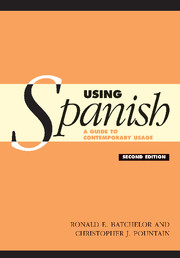Book contents
- Frontmatter
- Contents
- Authors' acknowledgements
- Preface to the second edition
- List of abbreviations and symbols
- Glossary
- The Spanish speaking world: countries where Spanish is spoken, with an estimate of the numbers of native speakers
- 1 Introduction
- 2 Passages illustrating register and local variety
- Part I Vocabulary
- 3 Misleading similarities between Spanish and English
- 4 Similarities between Spanish words
- 5 Fields of meaning – vocabulary extension
- 6 Complex verbal expressions
- 7 Affective suffixes
- 8 Idioms, similes and proverbs
- 9 Proper names
- 10 Adjectives pertaining to countries and towns
- 11 Abbreviations
- 12 Latin expressions
- 13 Anglicisms
- 14 Grammatical terms
- 15 Interjections
- 16 Fillers
- 17 Transition words
- 18 Numerals
- 19 Measurements
- 20 Semi-technical vocabulary
- Part II Grammar
- Index
16 - Fillers
Published online by Cambridge University Press: 05 June 2012
- Frontmatter
- Contents
- Authors' acknowledgements
- Preface to the second edition
- List of abbreviations and symbols
- Glossary
- The Spanish speaking world: countries where Spanish is spoken, with an estimate of the numbers of native speakers
- 1 Introduction
- 2 Passages illustrating register and local variety
- Part I Vocabulary
- 3 Misleading similarities between Spanish and English
- 4 Similarities between Spanish words
- 5 Fields of meaning – vocabulary extension
- 6 Complex verbal expressions
- 7 Affective suffixes
- 8 Idioms, similes and proverbs
- 9 Proper names
- 10 Adjectives pertaining to countries and towns
- 11 Abbreviations
- 12 Latin expressions
- 13 Anglicisms
- 14 Grammatical terms
- 15 Interjections
- 16 Fillers
- 17 Transition words
- 18 Numerals
- 19 Measurements
- 20 Semi-technical vocabulary
- Part II Grammar
- Index
Summary
In conversation, speakers often need time to formulate what they are going to say, and therefore make use of a range of introductory ‘hesitation formulae’ or ‘fillers’. While overuse of such words can be annoying, their judicious use adds authenticity to a foreigner's speech – as well as giving time to think! The following are the most common such expressions in Spanish. English equivalents are suggested, but really their ‘meaning’ is minimal.
• al fin y al caboin the end, when all is said and done
Al fin y al cabo tuvo algo de razón
• †bueno
well Used almost automatically when answering a question; also to call attention, eg: ¿Cuándo piensas volver? – Bueno, no sé … Bueno, ¿estás listo?
• ¿cómo se diría?how shall I put it?
Pues (¿cómo se diría?), es como una fruta
• digamoslet's say
Digamos que, al fin y al cabo, todo tiene relación
• digámoslo asías it were
El alcohol es otra manera de escaparse, digámoslo así
• en finso, there it is
Often used in isolation to conclude a point.
En fin, no sé qué decirte
• entoncesthen
Frequently with pues (see below).
Pues entonces, le daremos un aprobado
• es quethe thing is, was
Es que estaba enferma mi madre
• estoer
Signifies deliberation.
Esto … bueno, ya veremos
• †hombregoodness, really
Hombre, pues cuesta mucho
• †mira/mirelook here
Mira, no tengo ni idea
• no séI don't know
No sé, digamos que vendrá mañana
• o seaor, that is
Also used as a general hesitation.
Se puede hacer esta tarde, o sea, si vienes después del almuerzo
Bueno, es que … o sea, no te puedo decir nada
• podríamos deciras one might say
[…]
- Type
- Chapter
- Information
- Using SpanishA Guide to Contemporary Usage, pp. 237 - 238Publisher: Cambridge University PressPrint publication year: 2005



